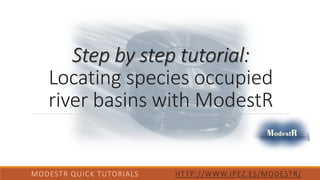15. Locating species occupied river basins with ModestR (Version ModestR 5.3 or higher)
- 1. Step by step tutorial: Locating species occupied river basins with ModestR MODESTR QUICK TUTORIALS HTTP://WWW.IPEZ.ES/MODESTR/
- 2. What do you need for this tutorial: 1. ModestR software installed (this tutorial is done with Modestr V.5.3) 2. Internet connection 3. About 10 minutes MODESTR QUICK TUTORIALS HTTP://WWW.IPEZ.ES/MODESTR/ ModestR software can be freely downloaded from http://www.ipez.es/ModestR
- 3. 1. Let’s suppose you want to download occurrence records from GBIF. Then select File/Import/Occurrences from online GBIF database MODESTR QUICK TUTORIALS HTTP://WWW.IPEZ.ES/MODESTR/ Other options already exist such as importing occurrence data from a CSV file, from KML files, shapefiles, etc. All those options are explained in the ModestR Tutorial No. 1 available in the ModestR website.
- 4. 2. In the dialog box that will appear we will enter a species name. MODESTR QUICK TUTORIALS HTTP://WWW.IPEZ.ES/MODESTR/ Other options already exist to select which kind of records to download from GBIF, and to use synonyms. All those options are explained in the ModestR User’s Tutorial available in the ModestR website. Type the species name in the textbox. For example “Leptinotarsa decemlineata” (the potato beetles). Then accept.
- 5. 3. The next step will query GBIF database how many occurrence records there are for the selected species. It will display this information and ask you to confirm you want to continue downloading (the number of occurrences will probably not be the same than in this picture. Don’t worry! It depends on the options and the current available data in GBIF) MODESTR QUICK TUTORIALS HTTP://WWW.IPEZ.ES/MODESTR/ Just click on the Accept button to continue downloading occurrence data from GBIF.
- 6. 4. Downloading of occurrence records will be done. Wait a few minutes. When download finished, click on accept and continue. MODESTR QUICK TUTORIALS HTTP://WWW.IPEZ.ES/MODESTR/
- 7. 5. Select the valid habitats for the species. In this case, it is the Land habitat. This information will be used by MapMaker to automatically check occurrences validity. MODESTR QUICK TUTORIALS HTTP://WWW.IPEZ.ES/MODESTR/ Check the Land habitat and the Accept button to continue There are other options to clean imported data. Now we’ll just use the default settings. But all those options are explained in the ModestR User’s Manual available in the ModestR website. By default, occurrences will autochecked. That is, ModestR will automatically check occurrences validity regarding the habitat.
- 8. 6. Once imported, MapMaker will display a brief summary of the imported, valid and invalid occurrences. (Remember, numbers may not be the same than in those pictures. That depends on used options) MODESTR QUICK TUTORIALS HTTP://WWW.IPEZ.ES/MODESTR/
- 9. 7. You can also save a CSV file with all downloaded data, including GBIF information about data sources, rights and citation information. MODESTR QUICK TUTORIALS HTTP://WWW.IPEZ.ES/MODESTR/
- 10. MODESTR QUICK TUTORIALS HTTP://WWW.IPEZ.ES/MODESTR/ 8. Now imported data are shown on the map. By default samples are automatically checked regarding species valid habitats, and displayed using different colors.
- 11. 9. We’ll now search for species occupied river basins. MODESTR QUICK TUTORIALS HTTP://WWW.IPEZ.ES/MODESTR/ Go to menú Layer/Shapes/Add river basins with occurrences This option will just add visual shapes to the map. In ModestR those shapes don’t represent presence areas. They are just for visualization purposes (See step by step tutorial Working with shapes in ModestR for more details.).
- 12. 10. You have two options: a) searching river basins of a specific level where there are species occurrences. River basins are organized by levels, from lower levels (larger basins) to higher ones (smaller basins). See step by step tutorial Working with shapes in ModestR for more details. b) Searching for the minimal set of contiguous basins that cover all species occurrences. MODESTR QUICK TUTORIALS HTTP://WWW.IPEZ.ES/MODESTR/ Select search option then click on OK button
- 13. 11. For example, this will be the result for minimal contiguous basins. MODESTR QUICK TUTORIALS HTTP://WWW.IPEZ.ES/MODESTR/ You can clear all shapes with this button: Then test again using other different options.
- 14. 12. This will be the result using the option of looking for occupied river basins of level 3. MODESTR QUICK TUTORIALS HTTP://WWW.IPEZ.ES/MODESTR/ Obviously, when using a specific river basin level, contiguity cannot be guaranteed.
- 15. 13. Once you have found the best option for you, you can eventually add the founded basins as presence areas for the species. MODESTR QUICK TUTORIALS HTTP://WWW.IPEZ.ES/MODESTR/ Go to menu Layers/Shapes/Convert to presence areas to add presence areas corresponding to the shapes currently shown on the map.
- 16. 14. You must select the valid habitat for the species. MODESTR QUICK TUTORIALS HTTP://WWW.IPEZ.ES/MODESTR/ For this example, as we used a terrestrial species, we’ll select Land habitat then Accept.
- 17. 15. Presence areas will be added to the map (the color may be different depending on your settings). Shapes can now be deleted from the map (see step 11). MODESTR QUICK TUTORIALS HTTP://WWW.IPEZ.ES/MODESTR/
- 18. It was the Step by step tutorial: Locating species occupied river basins with ModestR Thank you for your interest. MODESTR QUICK TUTORIALS HTTP://WWW.IPEZ.ES/MODESTR/? You can find this one and other tutorials in http://www.ipez.es/ModestR


















